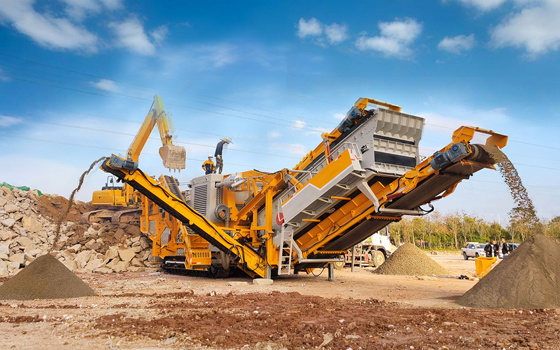Essential Components of Jaw Crushers: A Comprehensive Guide
Release Time:
2025-08-10
Author:
Source:
Essential Components of Jaw Crushers: A Comprehensive Guide Table of Contents 1. Introduction to Jaw Crushers 2. Key Components of Jaw Crushers 2.1 Jaw Plates 2.2 Frame 2.3 Eccentric Shaft 2.4 Toggle Plate 2.5 Drive Motor 2.6 Bearings 3. Working Principle of Jaw Crushers 4. Maintenance Tips for Jaw Crushers
Essential Components of Jaw Crushers: A Comprehensive Guide
Table of Contents
- 1. Introduction to Jaw Crushers
- 2. Key Components of Jaw Crushers
- 3. Working Principle of Jaw Crushers
- 4. Maintenance Tips for Jaw Crushers
- 5. Common Issues and Troubleshooting
- 6. Frequently Asked Questions
- 7. Conclusion
1. Introduction to Jaw Crushers
Jaw crushers are a cornerstone in the world of crushing equipment, primarily used in the mining and construction industries. They are designed to reduce large rocks into smaller rocks, gravel, or rock dust. Their robust construction and efficient performance make them a popular choice for a wide range of crushing applications. Understanding the essential components of jaw crushers is crucial for optimizing their performance, enhancing durability, and ensuring the overall efficiency of the crushing process.
2. Key Components of Jaw Crushers
A jaw crusher consists of several critical components that play a vital role in its function. Each part is designed to work in harmony, contributing to the machine's overall efficiency.
2.1 Jaw Plates
**Jaw plates** are the primary components that come into direct contact with the material being crushed. They are usually made from high-quality manganese steel, which provides excellent wear resistance. The design of jaw plates varies, with options like smooth or corrugated surfaces, affecting the material's grip. Regular inspection and replacement of jaw plates are essential to maintain effective crushing performance.
2.2 Frame
The **frame** of a jaw crusher is its backbone, providing structural integrity and support. Typically made from heavy-duty steel, the frame must withstand the immense forces generated during the crushing process. The design includes various reinforcements to prevent deformation or failure under load. A well-constructed frame contributes to the longevity and stability of the entire machine.
2.3 Eccentric Shaft
The **eccentric shaft** is a crucial component that converts the rotary motion of the drive motor into the back-and-forth motion needed to crush material. It is fitted with heavy-duty bearings, which support its rotation and allow it to maintain the alignment necessary for optimal crushing action. Ensuring the eccentric shaft is properly lubricated and free of wear is vital for maintaining performance.
2.4 Toggle Plate
The **toggle plate** serves as a safety device and a means for transferring motion from the eccentric shaft to the jaw plates. It is designed to absorb the shock loads generated during crushing, protecting other components from damage. If the material being crushed becomes too tough, the toggle plate will break, preventing further damage to the machine. Regular monitoring of the toggle plate condition is essential for operational safety.
2.5 Drive Motor
The **drive motor** powers the entire jaw crusher, providing the energy required for the crushing process. It can either be an electric motor or a hydraulic drive, depending on the application and size of the machine. Selecting a motor with the appropriate power and efficiency rating is critical to ensure consistent performance. Regular maintenance of the drive motor ensures optimal operation and longevity.
2.6 Bearings
**Bearings** are integral to the smooth operation of the jaw crusher. They support the movement of various components, primarily the eccentric shaft. High-quality bearings reduce friction, enhancing efficiency and prolonging the life of the machine. Lubrication and regular inspection of bearings are essential to prevent failure and maintain performance.
3. Working Principle of Jaw Crushers
Understanding the working principle of jaw crushers is essential for analyzing their performance. The jaw crusher operates on a simple yet effective principle: when the movable jaw swings towards the fixed jaw, material is trapped and crushed between the two surfaces. The size of the crushed material can be adjusted by changing the gap between the jaws. The materials being crushed are gradually reduced in size as they are forced down through the machine, exiting at the bottom.
The energy generated by the drive motor is transmitted through the eccentric shaft, causing the movable jaw to pivot. This motion creates a crushing action, allowing larger rocks to be effectively broken down into smaller, manageable sizes.
4. Maintenance Tips for Jaw Crushers
Regular maintenance is crucial for ensuring the longevity and efficient operation of jaw crushers. Here are some best practices:
- **Routine Inspection**: Regularly inspect all components, including jaw plates, bearings, and the frame for wear and tear.
- **Lubrication**: Ensure that all moving parts are adequately lubricated to reduce friction and wear. Follow manufacturer recommendations for lubrication schedules.
- **Jaw Plate Replacement**: Replace worn jaw plates promptly to maintain optimal crushing performance and prevent excessive wear on other components.
- **Tension Adjustment**: Regularly check and adjust the tension of the toggle plate to ensure proper operation and prevent damage.
- **Cleanliness**: Keep the machine clean and free from debris to prevent blockages and maintain efficient operation.
5. Common Issues and Troubleshooting
Even with regular maintenance, jaw crushers can encounter issues. Here are some common problems and their potential solutions:
- **Excessive Noise**: This may indicate wear in bearings or misalignment. Inspect and replace worn parts as necessary.
- **Poor Crushing Performance**: If the crusher is not performing as expected, check the jaw plates for wear and ensure proper tensioning of the toggle plate.
- **Overheating**: This could be due to inadequate lubrication or a malfunctioning drive motor. Ensure all components are properly lubricated and functioning correctly.
- **Material Blockages**: Regularly monitor for blockages in the feed hopper or discharge area, which can hinder performance. Clear obstructions promptly.
6. Frequently Asked Questions
**Q1: What materials can be processed by jaw crushers?**
Jaw crushers can process a wide range of materials, including hard rocks, minerals, and recycled materials. Their versatility makes them suitable for various industries.
**Q2: How often should jaw plates be replaced?**
The frequency of jaw plate replacement depends on the material being processed and the operating conditions. Generally, they should be inspected regularly and replaced when wear exceeds manufacturers’ specifications.
**Q3: What is the ideal gap between jaw plates?**
The ideal gap between the jaw plates varies depending on the material size and desired output. It can typically be adjusted between 1-6 inches, depending on the application.
**Q4: Are there different types of jaw crushers?**
Yes, there are several types of jaw crushers, including single toggle and double toggle models. Each has its unique design and operational characteristics.
**Q5: What safety measures should be taken while operating a jaw crusher?**
Operators should wear appropriate personal protective equipment (PPE), ensure all safety guards are in place, and follow manufacturer guidelines for operation and maintenance.
7. Conclusion
In conclusion, understanding the essential components of jaw crushers is vital for anyone involved in mining, construction, or material processing. Each component plays a critical role in ensuring the machine's efficiency, durability, and performance. Regular maintenance and timely replacements can significantly enhance the lifespan of these machines, ultimately leading to improved productivity and cost-effectiveness. By following the insights provided in this guide, operators can optimize their jaw crusher operations, ensuring they achieve the desired results in their crushing tasks. Investing in knowledge and maintenance will lead to better performance and longer operational life for your equipment.
Keywords:
Jaw crusher parts | Shredder parts | Cone crusher Parts | Ball mill parts
Previous page
Previous page:
Related News









